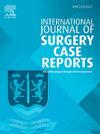IF 0.6
Q4 SURGERY
引用次数: 0
摘要
背景自发性膀胱破裂(SRUB)是一种罕见但危及生命的急症,通常表现为非特异性症状,导致诊断延误和腹膜炎、败血症和多器官功能衰竭等严重并发症。在极少数情况下,SRUB 可能会出现多器官功能障碍,包括急性肝功能和肾功能衰竭,使治疗和康复更加复杂。我们报告了一名有良性前列腺增生(BPH)病史的 58 岁男性患者,他出现急性腹痛、发热、黄疸和血流动力学不稳定。实验室检查发现白细胞增多、肾功能损害、代谢性酸中毒和高钾血症,以及胆红素和肝酶水平升高。腹盆腔 CT 和膀胱造影证实了 SRUB,显示造影剂外渗。患者接受了紧急剖腹探查术,术中发现两处膀胱撕裂,并成功进行了修补。术后护理包括广谱抗生素、血液透析和强化监测,最终患者完全康复。讨论SRUB由于与胃肠道和肾脏病变相似,经常被误诊。本病例强调了对有膀胱出口梗阻等危险因素的患者高度怀疑的重要性。CT 膀胱造影对早期诊断至关重要,而手术修补仍是治疗的金标准。包括血液透析和感染控制在内的支持性护理对于优化治疗效果至关重要。临床医生应考虑急腹症和已知膀胱功能障碍患者的这种罕见情况,以降低发病率并改善预后。本文章由计算机程序翻译,如有差异,请以英文原文为准。
Spontaneous rupture of the urinary bladder with acute hepatic and renal failure: a case report
Background
Spontaneous rupture of the urinary bladder (SRUB) is a rare but life-threatening emergency that often presents with nonspecific symptoms, leading to delayed diagnosis and severe complications such as peritonitis, sepsis, and multi-organ failure. In rare cases, SRUB may present with multiorgan dysfunction including acute liver and kidney failure, complicating management and recovery. It is commonly associated with underlying bladder dysfunction, including chronic urinary retention and bladder outlet obstruction.
Case presentation
We report a 58-year-old male with a history of benign prostatic hyperplasia (BPH) who presented with acute abdominal pain, fever, jaundice, and hemodynamic instability. Laboratory tests revealed leukocytosis, renal impairment, metabolic acidosis, and hyperkalemia, as well as elevated bilirubin and liver enzyme levels. Abdominopelvic CT with cystography confirmed SRUB, showing contrast extravasation. The patient underwent an urgent exploratory laparotomy, which revealed two bladder tears that were successfully repaired. Postoperative care included broad-spectrum antibiotics, hemodialysis, and intensive monitoring, leading to a full recovery.
Discussion
SRUB is often misdiagnosed due to its resemblance to gastrointestinal and renal pathologies. This case highlights the importance of a high index of suspicion in patients with risk factors such as bladder outlet obstruction. CT cystography is crucial for early diagnosis, while surgical repair remains the gold standard for treatment. Supportive care, including hemodialysis and infection control, is vital for optimizing outcomes.
Conclusion
Early recognition and prompt surgical intervention are critical in managing SRUB. Clinicians should consider this rare condition in patients with acute abdomen and known bladder dysfunction to reduce morbidity and improve prognosis.
求助全文
通过发布文献求助,成功后即可免费获取论文全文。
去求助
来源期刊
CiteScore
1.10
自引率
0.00%
发文量
1116
审稿时长
46 days

 求助内容:
求助内容: 应助结果提醒方式:
应助结果提醒方式:


